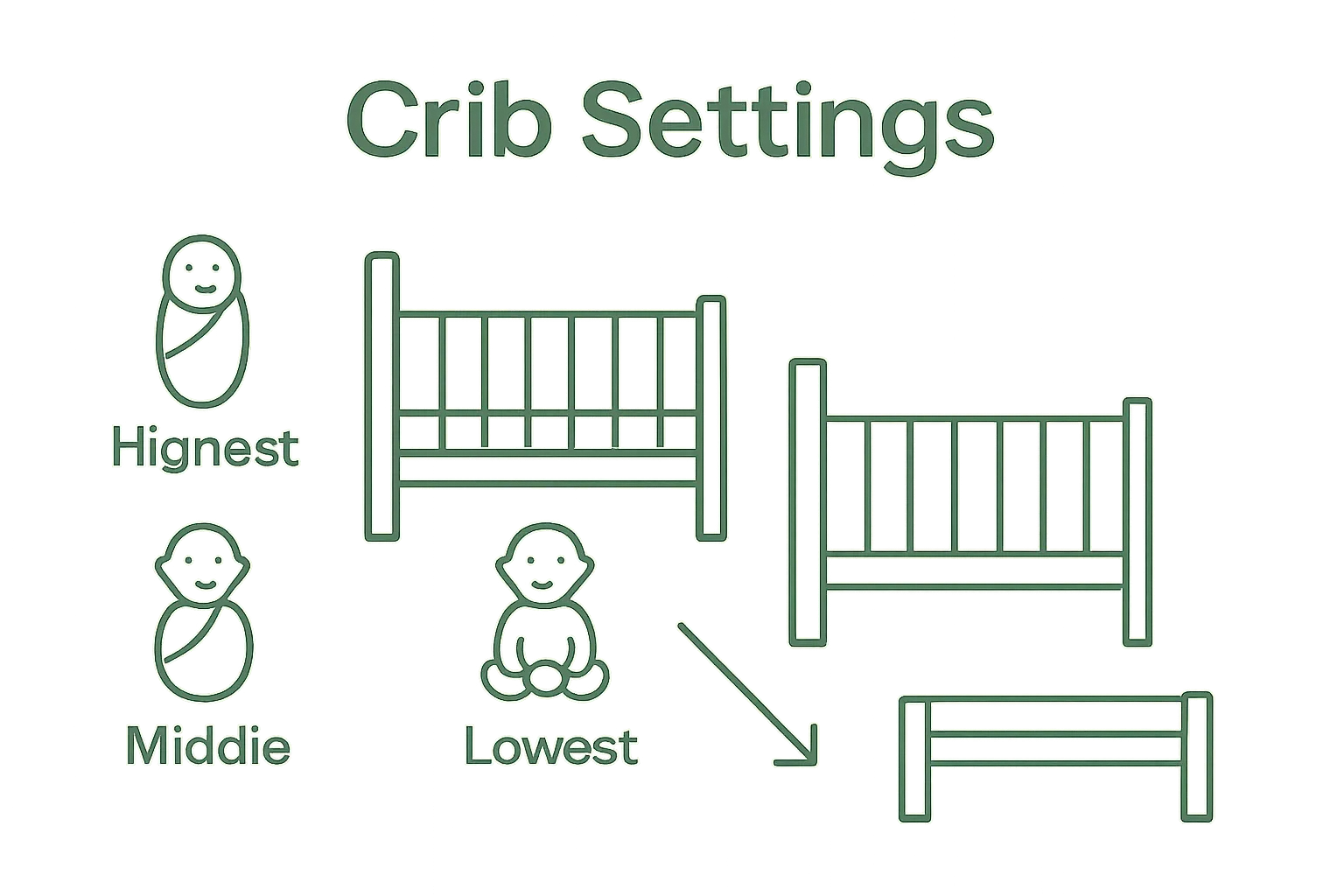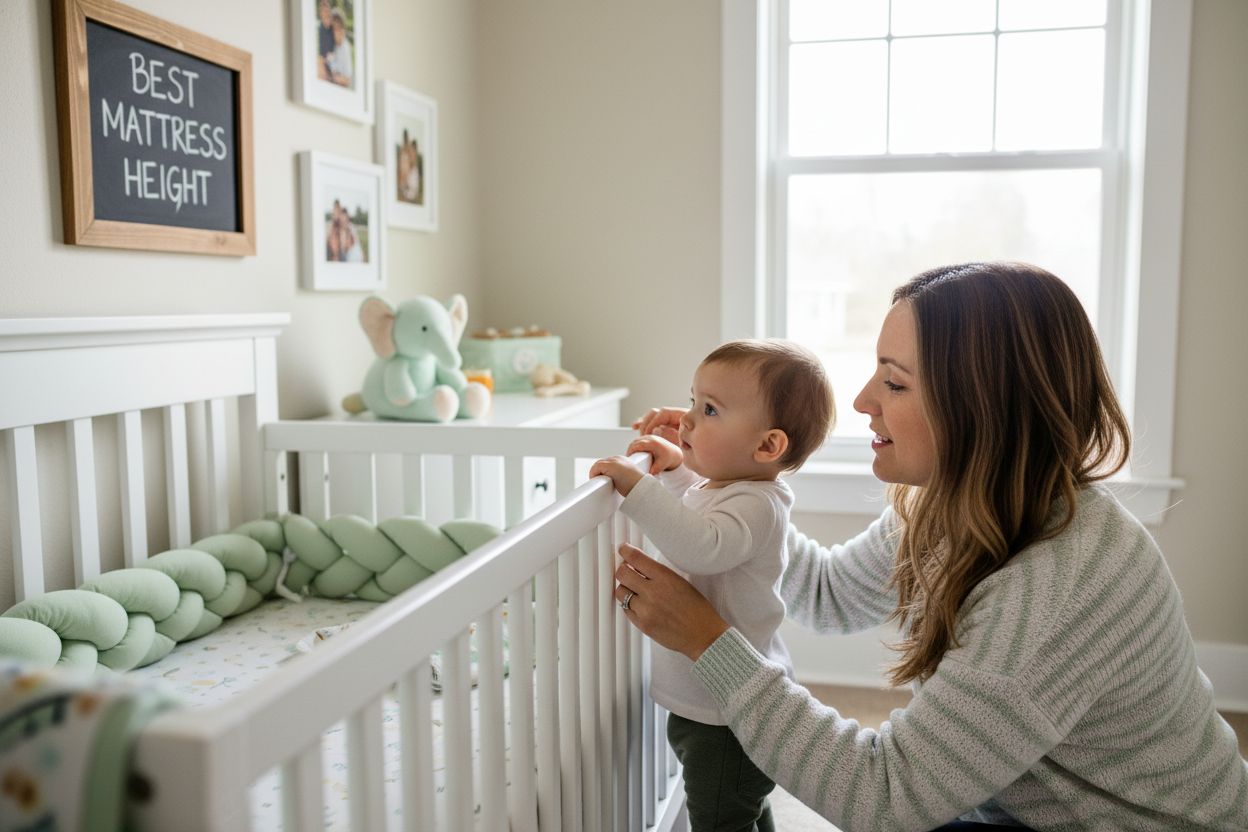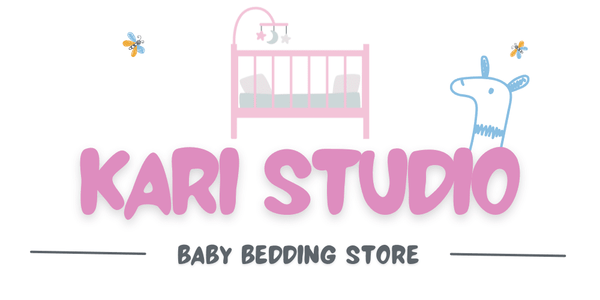Adjusting the height of your baby’s crib mattress seems simple at first glance. Most cribs offer 3 to 4 preset mattress positions to keep up with your baby’s rapid growth and mobility changes. Surprising, right? This feature is not just about convenience for parents. Making the right mattress adjustment at the right time could be the single most important factor standing between your child and a preventable accident.
Table of Contents
- What Is A Crib Mattress Height Adjustment?
- Why Lowering The Crib Mattress Is Critical For Safety
- How Does The Crib Mattress Adjustment Affect Baby Growth
- What Are The Signs It’s Time To Lower The Crib Mattress
- How To Determine The Best Mattress Height For Your Child
Quick Summary
| Takeaway | Explanation |
|---|---|
| Adjust crib mattress height for safety. | Regularly lower the mattress as your baby becomes more mobile to prevent falls and injuries. |
| Look for signs to lower the mattress. | Key indicators include independent sitting, pulling to stand, or attempts to climb out of the crib. |
| Consult manufacturer guidelines. | Always refer to your crib’s manual for specific height adjustment instructions and safety recommendations. |
| Monitor developmental milestones. | Progression in motor skills directly correlates with the need to adjust the mattress height for safety. |
| Create a responsive sleep environment. | Customizing the mattress height supports your child’s evolving mobility and cognitive development while enhancing safety. |
What is a Crib Mattress Height Adjustment?
A crib mattress height adjustment is a critical safety feature designed to accommodate your baby’s growth stages and developmental milestones. The process involves repositioning the mattress support frame at different levels within the crib, allowing parents to modify the vertical distance between the mattress surface and the top of the crib rails.
Understanding the Mechanics of Crib Mattress Height
Most cribs are engineered with multiple preset height settings, typically ranging from 3 to 4 different positions. These settings allow parents to lower the mattress as their child becomes more mobile and develops increased physical capabilities. Understanding crib mattress safety is fundamental to creating a secure sleep environment.
The primary objective of these adjustments is safety prevention. When babies are newborns and cannot sit up or pull themselves up, the mattress can remain at its highest setting, making it easier for parents to lift and place their infant. As babies grow and become more active, lowering the mattress becomes crucial to prevent potential falls and injuries.
Key Considerations for Mattress Height Adjustment
Several critical factors determine when and how to adjust your crib mattress height:
- Infant Age: Newborns can use the highest mattress setting, while more mobile infants require lower positions.
- Baby’s Physical Development: Once your child can sit unassisted or shows signs of pulling up, it is time to lower the mattress.
- Crib Manufacturer Guidelines: Always consult your specific crib’s manual for precise adjustment instructions and safety recommendations.
Typically, the first mattress height adjustment occurs around 4-5 months when babies start showing increased mobility. The final and lowest setting is usually recommended when the child is approximately 35 inches tall or can stand up independently, which often happens between 18-24 months.
Parents should view mattress height adjustment not just as a mechanical task but as a proactive safety measure that evolves with their child’s developmental journey. Regular assessment and timely adjustments can significantly reduce the risk of potential accidents and provide a secure sleeping environment.
The table below summarizes when to lower your crib mattress based on your baby’s developmental milestones, physical abilities, and manufacturer recommendations.
| Crib Mattress Setting | Suitable Developmental Stage | Typical Age Range | Key Signs / Triggers |
|---|---|---|---|
| Highest | Newborn (unable to sit or move independently) | 0-4 months | Baby cannot sit, pull up, or roll over |
| Middle | Beginning mobility (can roll or sit supported) | 4-6 months | Rolling over, possibly sitting with assistance |
| Lower | Increased mobility (can sit unassisted) | 6-9 months | Sits unassisted, may pull up, approaching standing |
| Lowest (Final) | Standing or attempting to climb | 9-24 months | Pulls up to stand, attempts to climb, ~32-35 inches |
Why Lowering the Crib Mattress is Critical for Safety
Lowering the crib mattress is an essential safety strategy that directly prevents potential infant injuries and protects children during their most vulnerable developmental stages. The primary objective is to create a physical barrier that minimizes the risk of falls, climbing accidents, and potential head injuries as babies become increasingly mobile and curious about their surroundings.
Understanding Developmental Risk Progression
As babies grow, they progress through rapid physical development stages that dramatically increase their risk of accidental falls. Understanding crib safety standards is fundamental to preventing these potential hazards. When infants begin to sit unassisted, pull themselves up, or attempt to climb, the height of the crib mattress becomes a critical safety consideration.
Research indicates that most infant injuries occur during transitional developmental periods when children are exploring their physical capabilities but lack complete motor control. By strategically lowering the mattress, parents create a protective environment that adapts to the child’s changing physical abilities.
Critical Safety Considerations
Multiple factors contribute to the importance of crib mattress height adjustments:
- Fall Prevention: As babies become more mobile, a higher mattress increases the potential fall distance.
- Climbing Deterrence: Lower mattress settings make it more challenging for curious babies to attempt climbing over crib rails.
- Head Injury Mitigation: Reducing the vertical distance between the mattress and crib top minimizes potential impact zones.
Pediatric safety experts recommend progressive mattress lowering as children demonstrate increased physical capabilities. The goal is to create a dynamic safety environment that evolves with the child’s developmental milestones. Parents should remain vigilant and proactively adjust the mattress height before their child reaches a stage where they could potentially climb or fall.
Ultimately, lowering the crib mattress is not just a recommended practice but a critical intervention that directly impacts infant safety. By understanding and implementing these adjustments, parents can significantly reduce the risk of accidental injuries during a child’s most exploratory and vulnerable developmental stages.
This table outlines the critical safety considerations associated with each stage of crib mattress height adjustment to help parents understand the impact of each change.
| Safety Consideration | Description | Why It Matters |
|---|---|---|
| Fall Prevention | Lowering reduces potential fall distance | Reduces risk of injury as baby becomes more mobile |
| Climbing Deterrence | Makes climbing over crib rails more difficult | Prevents escape and dangerous falls |
| Head Injury Mitigation | Minimizes vertical space for accidental impacts | Lowers risk of serious head or body injuries |
| Adapting to Development | Matches mattress height to baby’s physical development | Evolves sleep safety as child reaches new milestones |
How Does the Crib Mattress Adjustment Affect Baby Growth
Crib mattress height adjustments play a crucial role in supporting infant physical development, creating an environment that adapts to a child’s evolving motor skills and mobility milestones. These strategic adjustments are not merely safety mechanisms but integral components of developmental support that facilitate natural progression and exploration.
Physical Development and Spatial Interactions
As infants transition through various developmental stages, their interaction with physical space becomes increasingly complex. Understanding when to transition to crib helps parents comprehend how environmental modifications support cognitive and physical growth. Each mattress height adjustment corresponds to specific developmental windows, allowing babies to safely practice emerging motor skills such as sitting, pulling up, and eventually standing.

Research suggests that providing an appropriately configured environment encourages infants to develop muscle strength, spatial awareness, and confidence in their physical capabilities. By modifying the mattress height, parents create a controlled space that challenges yet protects their child during critical neurological and muscular development periods.
Developmental Milestone Correlations
Crib mattress adjustments directly correlate with key developmental milestones:
- Motor Skill Progression: Lower mattress heights enable safer exploration of new physical capabilities.
- Muscle Strength Development: Different mattress levels encourage varied muscle engagement and movement patterns.
- Cognitive Spatial Learning: Changing environment stimulates infant understanding of physical boundaries and movement.
Pediatric experts emphasize that these adjustments are not just about preventing falls but about creating a dynamic learning environment. As babies transition from passive lying to active exploration, the crib becomes a critical training ground for developing fundamental movement skills.
Ultimately, crib mattress height adjustments represent more than a safety feature. They are a nuanced approach to supporting infant growth, providing a responsive environment that evolves alongside a child’s expanding physical and cognitive capabilities. Parents who understand and implement these strategic modifications contribute significantly to their child’s developmental journey.
What Are the Signs It’s Time to Lower the Crib Mattress
Recognizing the right moment to lower a crib mattress requires keen observation of an infant’s physical development and emerging mobility skills. Parents must remain vigilant and proactive in identifying specific developmental indicators that signal the need for immediate mattress height adjustment to ensure continued safety.
Developmental Mobility Indicators
Understanding when to transition from crib helps contextualize the critical signs that suggest it is time to modify the mattress height. The progression of infant mobility follows a predictable pattern, with certain physical milestones serving as clear signals for parents to take action.
According to the U.S. Consumer Product Safety Commission, specific developmental stages indicate the immediate need for mattress height adjustment. These stages represent crucial transition points where an infant’s increasing physical capabilities introduce new potential safety risks.
Critical Physical Milestones to Watch
Parents should consider lowering the crib mattress when observing the following key signs:
- Independent Sitting: When babies can sit unassisted without support for extended periods.
- Pulling to Stand: The ability to pull themselves up using crib rails indicates increased mobility.
- Attempted Climbing: Any signs of the baby trying to climb or lean over the crib rails.
- Height Measurements: When the baby reaches approximately 32 inches tall or demonstrates advanced motor skills.
Typically, these developmental milestones occur between 4 to 6 months of age, though individual progression varies. Some babies might reach these stages earlier or later, emphasizing the importance of continuous monitoring rather than relying solely on age-based recommendations.
Ultimately, mattress height adjustment is not a one-time event but a dynamic process that requires ongoing assessment. Parents must remain attentive to their child’s unique developmental trajectory, understanding that each infant progresses differently. By recognizing and responding promptly to these physical signs, caregivers can create a safer, more supportive sleep environment that adapts to their child’s growing capabilities.
How to Determine the Best Mattress Height for Your Child
Determining the optimal crib mattress height requires a comprehensive approach that balances infant safety, developmental stages, and individual physical characteristics. Parents must integrate multiple considerations to create a secure sleep environment that adapts to their child’s evolving capabilities.
Comprehensive Assessment Strategies
Do babies need additional sleep safety considerations helps parents understand the nuanced approach required for creating a safe sleep environment. The mattress height selection is not a uniform process but a personalized strategy that depends on multiple interconnected factors.
Pediatric ergonomics experts emphasize that mattress height determination goes beyond simple age-based recommendations. Each adjustment should be a deliberate decision informed by the child’s specific developmental trajectory, physical capabilities, and individual growth patterns.
Key Factors in Mattress Height Selection
Parents should consider the following critical elements when determining the most appropriate mattress height:
- Current Physical Capabilities: Assess the baby’s ability to sit, pull up, and potential climbing attempts.
- Body Measurements: Consider the child’s height and weight in relation to crib dimensions.
- Mobility Level: Evaluate the infant’s current and anticipated movement patterns.
- Manufacturer Guidelines: Strictly adhere to specific crib and mattress manufacturer recommendations.
Typically, mattress height adjustments follow a progressive pattern. The highest setting is appropriate for newborns who cannot sit or move independently. As babies develop muscle strength and mobility, parents should systematically lower the mattress to maintain a safe barrier that prevents potential falls or climbing attempts.
Ultimately, determining the best mattress height is a dynamic process requiring continuous observation and proactive adjustment. Parents must remain attentive to their child’s unique developmental journey, understanding that safety is not a static concept but an evolving strategy that adapts to changing physical capabilities. Regular assessment, careful monitoring, and a responsive approach are key to creating a secure sleep environment that supports healthy infant growth.

Upgrade Crib Safety and Comfort with Kari Studio Solutions
Understanding when to lower your crib mattress is about more than just following another parenting task. It’s about creating a safe and nurturing space for your baby as they reach new milestones like sitting up and pulling to stand. For many parents, this transition brings new worries about bumps and restless nights. That is why soft, protective crib bumpers become essential when adjusting mattress heights. Explore our Handmade Bumper Pads for Girl Cot or Handmade Bumper Pads for Boy Cot to find the perfect fit for your nursery’s needs.

Do not wait until an accident happens. Give your child the comfort and gentle security they need at every stage of growth. Visit Kari Studio’s braided crib bumper collection now and create a safer sleep space for your baby today.
Frequently Asked Questions
When should I lower my baby’s crib mattress?
You should consider lowering your baby’s crib mattress when they can sit unassisted or demonstrate signs of pulling themselves up, typically around 4-5 months of age. This adjustment is critical for preventing falls as your baby becomes more mobile.
What are the safety risks of not lowering the crib mattress?
Failing to lower the crib mattress can lead to increased risk of falls and injuries, especially as your baby learns to sit and stand. A higher mattress increases the potential distance of a fall, so it’s essential to lower it as your child’s mobility increases.
How can I determine the best mattress height for my child?
To determine the best mattress height, consider your child’s physical capabilities, such as their ability to sit or pull up, as well as their height and weight. Refer to the crib manufacturer’s guidelines and make adjustments based on your child’s unique development.
What are the recommended crib mattress height settings?
Most cribs feature 3 to 4 height settings. The highest setting is suitable for newborns, while lower settings are advised as your child reaches key mobility milestones, particularly when they are around 32 inches tall or attempting to stand independently.

